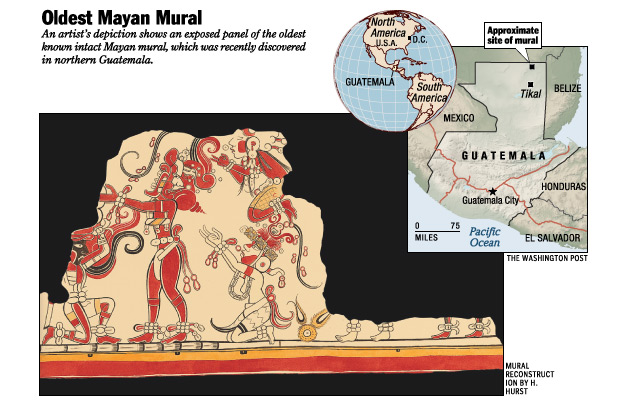Thursday, March 14, 2002; Page A11
Spectacular Mayan Mural Discovered By Accident

Spectacular Mayan Mural Discovered By Accident

By Guy Gugliotta
Washington Post Staff Writer
An archaeologist has discovered the oldest intact Mayan mural ever seen,
a spectacular colored fresco covered with mud in a hidden room buried within
a
jungle-cloaked pyramid in northern Guatemala's Peten wilderness.
University of New Hampshire archaeologist William Saturno said yesterday
that he found the mural accidentally during what appeared to be a futile
hunt for Mayan
stone monuments at a remote site two days' journey north of the world-famous
Classical Mayan ruins at Tikal.
"I wandered into a looters' trench beneath the pyramid, looking for
some shade as much as anything," Saturno said. "When I shined my flashlight
up at the wall, there
it was. I just started laughing."
What he saw was a four-foot-long swath of mural depicting the resurrection
of the Corn God, a scene from Mayan creation myth recorded in murals and
literature
and on statues and pottery for more than 2,000 years of Mesoamerican
history.
At first glance, Saturno could tell the mural was about 2,000 years
old, because the artistic style closely resembled that of Tikal murals
rigorously dated at A.D. 100,
while amulets and other ornaments matched those on A.D. 100 figures
at Kaminaljuyu, a highland site near present-day Guatemala City.
But the Tikal murals were weather-beaten fragments from exterior surfaces.
What Saturno saw was a three-foot-tall continuous band -- immaculately
preserved and
painted in black, red and "several shades of yellow," he said.
And the work, although hidden beneath stones and other debris, appeared
to extend around the top of the entire room. "We're talking a minimum 18
meters [nearly
60 feet] of mural," he said.
"We've seen nothing like this," said Mayan religion and art specialist
Karl A. Taube of the University of California at Riverside. "We didn't
know there was a mural
tradition this elaborate, this early."
Saturno made his discovery a year ago. He returned to the United States,
obtained an emergency grant from the National Geographic Society and hired
guards to
discourage looters. This year he will begin a five-year excavation
under the auspices of Harvard University's Peabody Museum. A report of
his findings will appear in
the April edition of National Geographic magazine.
The Maya, one of the great civilizations of pre-Columbian America, flourished
in what is now Guatemala, Belize and El Salvador and parts of Honduras
and Mexico,
from early Preclassic times beginning about 2000 B.C. to the Spanish
conquest in the 16th century.
The new discovery dates from the end of the Preclassic, a transitional
period in which the axis of Mayan development shifted from the Mesoamerican
central
highlands north and east into the tropical forests extending through
what is now the Yucatan Peninsula.
Archaeologists generally regard the ensuing Classical period between
A.D. 250 and 900 as the pinnacle of a culture that produced elaborate writing
and numbering,
a calendar system and remarkable art and architecture, much of which
remains unexcavated beneath the encroaching forest.
Saturno's site was untouched by archaeologists but riddled with holes,
tunnels and trenches carved by looters searching for marketable artifacts.
Saturno refused to
pinpoint the location, describing it only as 35 miles from the nearest
town and naming it "San Bartolo" after a now-defunct encampment where chicleros
once
harvested the tree sap from which chewing gum was made.
Saturno said the looters had punched their way through a wall at the
base of an 80-foot-high pyramid, one of two groupings of ceremonial architecture
in what had
been a 12.5-acre settlement.
Saturno explained that the wall was a short side of what appears to
have been a rectangular room next to an earlier version of the pyramid.
The Maya built temples
"onion-style," lifting them ever higher by putting new layers on top
of the old.
Before rebuilding the pyramid, the Maya decapitated the mural room and filled it with stones, ceramic shards and other debris, Saturno said.
But the Maya had also apparently "ceremonially killed" the room, smearing
the mural with mud so it would not be destroyed, he said. Saturno said
the mural was
painted on a fine sheen of plaster spread over coarse stucco slathered
on limestone building blocks.
"That's fabulous," said Yale art historian Mary E. Miller, a leading
authority on Mayan murals. "We won't know what there is until we really
can see what else is
there, but these are more spectacular [than most] because of the preservation
and the color scheme."
UC-Riverside's Taube said the mural depicts a core element of the Mayan
religion, in which the Maya's founding Hero Twins rescue their dead father,
the Corn God,
who is being dressed by young maidens before he leaves the underworld.
The uncovered portion of the mural shows the Corn God looking over his
shoulder at a kneeling woman on his left, while a man kneels at his right.
Saturno said the
first task of his excavators will be to save what has been uncovered
and determine what else there is.
© 2002